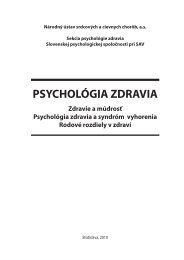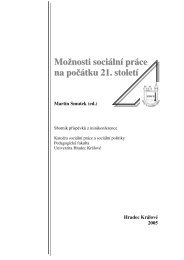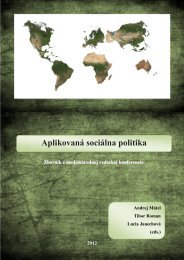Zmena klÃmy â možný dopad (nielen) na obyvateľstvo - Prohuman
Zmena klÃmy â možný dopad (nielen) na obyvateľstvo - Prohuman
Zmena klÃmy â možný dopad (nielen) na obyvateľstvo - Prohuman
You also want an ePaper? Increase the reach of your titles
YUMPU automatically turns print PDFs into web optimized ePapers that Google loves.
Results<br />
Results of Phase One<br />
Phase one of the research provided an indication of young children’s conceptions<br />
of global justice issues, factors which influence these conceptions, and strategies<br />
which might be developed to support young children’s engagement with issues of<br />
global justice.<br />
• Conceptions of Poverty and Fairness<br />
The findings suggest that young children’s understandings of poverty and justice<br />
are emergent. For younger children it appears that there is a conceptual understanding<br />
of people not having enough. The older children involved in the research,<br />
showed a greater tendency to use terms such as “poor” and “rich”. Poverty was<br />
more consistently understood by all children as the denial of, or lack of basic<br />
needs rather than a lack of money. Although children in each setting had an understanding<br />
of the importance of money, this was more evident among older children.<br />
The previous experience of children was an important factor in their engagement<br />
with ideas of poverty and need. Their understanding of food and water<br />
as needs, for example, and their own familiarity with the concepts of hunger and<br />
thirst e<strong>na</strong>bled them to engage with the materials provided. This concurs with the<br />
contention of Chafel et al. (2007) that children are more actively engaged when<br />
they can incorporate their own perso<strong>na</strong>l experiences.<br />
• Ability to Empathise<br />
Throughout the study and research settings there was ample evidence of the<br />
expression of feelings and emotions, concern and empathy for others. The children’s<br />
capacity to empathise was evident in their ability to describe how characters<br />
in the story and photographs used might be thinking or feeling. Across the<br />
research settings, children expressed concern and empathy for others perceived<br />
by them to be in need. This appeared to be grounded in their perso<strong>na</strong>l experiences<br />
and based on familiar sce<strong>na</strong>rios and contexts rather than on a larger global<br />
sense of justice and fairness. The findings are consistent with current post-structural<br />
theories of childhood which hold that children are capable of independent<br />
thinking and agency, and can understand issues beyond their own self-interest.<br />
• Stereotypical Conceptions of Africa<br />
While previous research has established that children can be influenced by racial<br />
stereotypes (Ruble and Martin, 1998; Connolly, 1998; Killen et al., 2001), this<br />
171

















